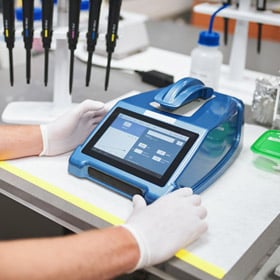
TriStar EMD Uses Spectrography to Solve a Metal Mystery
A long-time customer came to us with a product failure they thought was potentially caused by some bad plastic composite material. The material was Rulon®, which we have a long history with (we are sole North American distributor of this versatile line of high-performance filled-PTFE composites). The component in question used Rulon mated with brass and until recently had been working well.
The Initial Assumption Proved Inaccurate – But the Answer Was Close By

Our EMD (Enhanced Materials Division) team dug in and analyzed samples of the Rulon that were extracted from the failed parts. We quickly established that the Rulon material was within specs and, therefore, not at fault. The next step was to examine the metal mating hardware paired with the Rulon.
This is where our engineering team and our on-site chemist truly shine. Many plastic companies would not have the equipment or wherewithal to dig deeper to carefully evaluate non-plastic parts, but this is well within our wheelhouse!
Chemistry and Spectrography Reveal the Composition of Metallic Materials
Our team systematically looked at every aspect of the application to determine where the problem originated. Had something changed in the surface finish of the brass, or in the media transfer process? Did the machining technique change at some point? Was there a variation in secondary coatings or plating? It’s worth noting that during this process we did find some potential scenarios that could increase wear of the Rulon ─ none were the primary cause of the failure.
Digging deeper, our team took samples of two different lots of brass the customer had available to test. One from an old lot that did not have failures and one from a new lot that did. Using spectrography, high powered microscopes, surface profilometry, and a chemical process, we were finally able to narrow down the issue.
The Real Problem Was Revealed via Color Intensity Analysis
The percentage of copper in brass can be determined by reacting the brass sample with concentrated nitric acid, and then using the spectrometer to analyze the color intensity of the copper (II) nitrate solution that results. From this test we learned that, while the samples looked identical to the naked eye, there were, in fact, differences in the amount of copper in the two lots. The bad sample had 19% less copper than the good. This was the cause of the failure.
We worked with our customer to ensure that the copper content would be within specs moving forward and additionally made some recommendations for changes to the machining and surface treatment steps. Now the Rulon and brass parts are once again performing with the reliability and efficiency the customer demands.
This example showcases the sort of technical analysis our engineering team here at TriStar is capable of. If you think these services might be of use to you, we encourage you to reach out.









